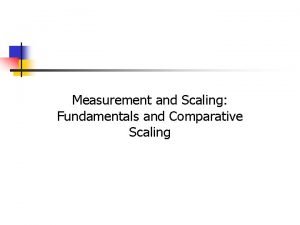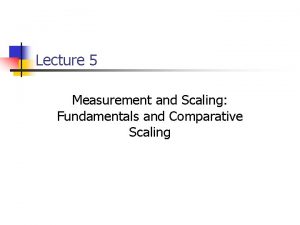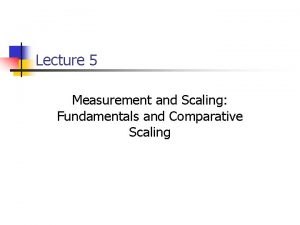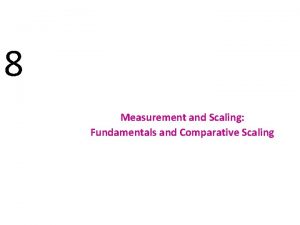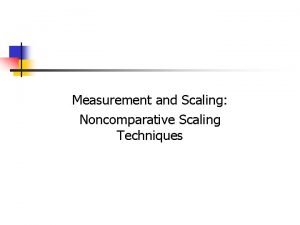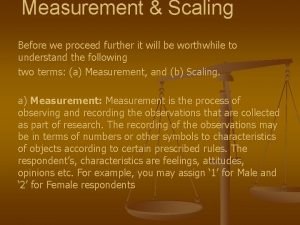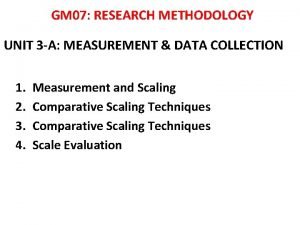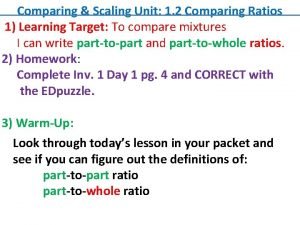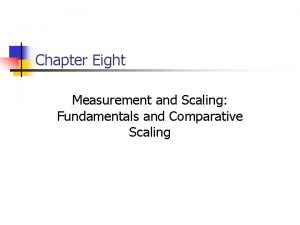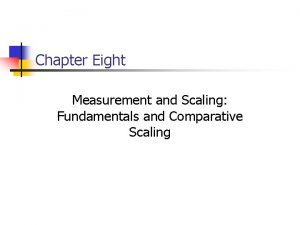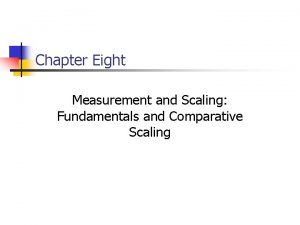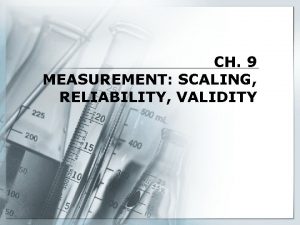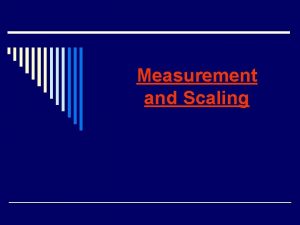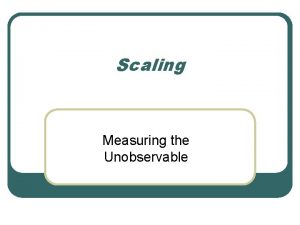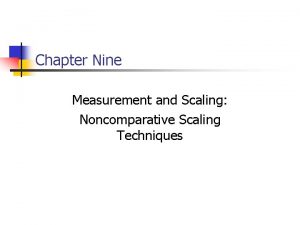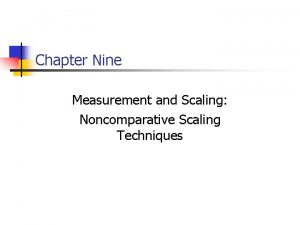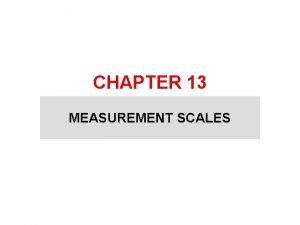Chapter Eight Measurement and Scaling Fundamentals and Comparative






























- Slides: 30

Chapter Eight Measurement and Scaling: Fundamentals and Comparative Scaling Copyright © 2010 Pearson Education, Inc. 8 -1

Chapter Outline 1) Overview 2) Measurement and Scaling 3) Scales Characteristics i. Description ii. Order iii. Distance iv. Origin Copyright © 2010 Pearson Education, Inc. 8 -2

Chapter Outline 4) Primary Scales of Measurement i. Nominal Scale ii. Ordinal Scale iii. Interval Scale iv. Ratio Scale 5) A Comparison of Scaling Techniques Copyright © 2010 Pearson Education, Inc. 8 -3

Chapter Outline 6) Comparative Scaling Techniques i. Paired Comparison ii. Rank Order Scaling iii. Constant Sum Scaling iv. Q-Sort and Other Procedures 7) Verbal Protocols 8) International Marketing Research 9) Ethics in Marketing Research 10) Summary Copyright © 2010 Pearson Education, Inc. 8 -4

Measurement and Scaling Measurement means assigning numbers or other symbols to characteristics of objects according to certain pre-specified rules. • • • One-to-one correspondence between the numbers and the characteristics being measured. The rules for assigning numbers should be standardized and applied uniformly. Rules must not change over objects or time. Copyright © 2010 Pearson Education, Inc. 8 -5

Scale Characteristics Description By description, we mean the unique labels or descriptors that are used to designate each value of the scale. All scales possess description. Order By order, we mean the relative sizes or positions of the descriptors. Order is denoted by descriptors such as greater than, less than, and equal to. Copyright © 2010 Pearson Education, Inc. 8 -6

Scale Characteristics Distance The characteristic of distance means that absolute differences between the scale descriptors are known and may be expressed in units. Origin The origin characteristic means that the scale has a unique or fixed beginning or true zero point. Copyright © 2010 Pearson Education, Inc. 8 -7

Measurement and Scaling involves creating a continuum upon which measured objects are located. Consider an attitude scale from 1 to 100. Each respondent is assigned a number from 1 to 100, with 1 = Extremely Unfavorable, and 100 = Extremely Favorable. Measurement is the actual assignment of a number from 1 to 100 to each respondent. Scaling is the process of placing the respondents on a continuum with respect to their attitude toward department stores. Copyright © 2010 Pearson Education, Inc. 8 -8

Primary Scales of Measurement Scale Fig. 8. 1 Nominal Numbers Finish Assigned to Runners Ordinal 7 8 3 Rank Order of Winners Interval Performance Rating on a 0 to 10 Scale Ratio Time to Finish in Seconds Copyright © 2010 Pearson Education, Inc. Finish Third place Second place First place 8. 2 9. 1 9. 6 15. 2 14. 1 13. 4 8 -9

Primary Scales of Measurement Nominal Scale • The numbers serve only as labels or tags for identifying and classifying objects. • When used for identification, there is a strict one-toone correspondence between the numbers and the objects. • The numbers do not reflect the amount of the characteristic possessed by the objects. • The only permissible operation on the numbers in a nominal scale is counting. • Only a limited number of statistics, all of which are based on frequency counts, are permissible, e. g. , percentages, and mode. Copyright © 2010 Pearson Education, Inc. 8 -10

Illustration of Primary Scales of Measurement Table 8. 2 Nominal Scale Ordinal Scale Interval Scale Ratio Scale No. Store Preference Rankings Preference Ratings 1 -7 11 -17 $ spent last 3 months 1. Parisian 2. Macy’s 3. Kmart 4. Kohl’s 5. J. C. Penney 6. Neiman Marcus 7. Marshalls 8. Saks Fifth Avenue 9. Sears 10. Wal-Mart Copyright © 2010 Pearson Education, Inc. 8 -11

Primary Scales of Measurement Ordinal Scale • A ranking scale in which numbers are assigned to objects to indicate the relative extent to which the objects possess some characteristic. • Can determine whether an object has more or less of a characteristic than some other object, but not how much more or less. • Any series of numbers can be assigned that preserves the ordered relationships between the objects. • In addition to the counting operation allowable for nominal scale data, ordinal scales permit the use of statistics based on centiles, e. g. , percentile, quartile, median. Copyright © 2010 Pearson Education, Inc. 8 -12

Primary Scales of Measurement Interval Scale • Numerically equal distances on the scale represent equal values in the characteristic being measured. • It permits comparison of the differences between objects. • The location of the zero point is not fixed. Both the zero point and the units of measurement are arbitrary. • Any positive linear transformation of the form y = a + bx will preserve the properties of the scale. • It is not meaningful to take ratios of scale values. • Statistical techniques that may be used include all of those that can be applied to nominal and ordinal data, and in addition the arithmetic mean, standard deviation, and other statistics commonly used in marketing research. Copyright © 2010 Pearson Education, Inc. 8 -13

Primary Scales of Measurement Ratio Scale • Possesses all the properties of the nominal, ordinal, and interval scales. • It has an absolute zero point. • It is meaningful to compute ratios of scale values. • Only proportionate transformations of the form y = bx, where b is a positive constant, are allowed. • All statistical techniques can be applied to ratio data. Copyright © 2010 Pearson Education, Inc. 8 -14

Primary Scales of Measurement Table 8. 1 Copyright © 2010 Pearson Education, Inc. 8 -15

A Classification of Scaling Techniques Figure 8. 2 Scaling Techniques Noncomparative Scales Comparative Scales Paired Comparison Rank Order Constant Q-Sort and Sum Other Procedures Likert Copyright © 2010 Pearson Education, Inc. Continuous Itemized Rating Scales Semantic Differential Stapel 8 -16

A Comparison of Scaling Techniques • Comparative scales involve the direct comparison of stimulus objects. Comparative scale data must be interpreted in relative terms and have only ordinal or rank order properties. • In noncomparative scales, each object is scaled independently of the others in the stimulus set. The resulting data are generally assumed to be interval or ratio scaled. Copyright © 2010 Pearson Education, Inc. 8 -17

Relative Advantages of Comparative Scales • Small differences between stimulus objects can be detected. • Same known reference points for all respondents. • Easily understood and can be applied. • Involve fewer theoretical assumptions. • Tend to reduce halo or carryover effects from one judgment to another. Copyright © 2010 Pearson Education, Inc. 8 -18

Relative Disadvantages of Comparative Scales • Ordinal nature of the data • Inability to generalize beyond the stimulus objects scaled. Copyright © 2010 Pearson Education, Inc. 8 -19

Comparative Scaling Techniques Paired Comparison Scaling • A respondent is presented with two objects and asked to select one according to some criterion. • The data obtained are ordinal in nature. • Paired comparison scaling is the most widely used comparative scaling technique. • With n brands, [n(n - 1) /2] paired comparisons are required. • Under the assumption of transitivity, it is possible to convert paired comparison data to a rank order. Copyright © 2010 Pearson Education, Inc. 8 -20

Obtaining Shampoo Preferences Using Paired Comparisons Fig. 8. 3 Instructions: We are going to present you with ten pairs of shampoo brands. For each pair, please indicate which one of the two brands of shampoo you would prefer for personal use. Recording Form: a. A 1 in a particular box means that the brand in that column was preferred over the brand in the corresponding row. A 0 means that the row brand was preferred over the column brand. b. The number of times a brand was preferred is obtained by summing the 1 s in each column. Copyright © 2010 Pearson Education, Inc. 8 -21

Paired Comparison Selling The most common method of taste testing is paired comparison. The consumer is asked to sample two different products and select the one with the most appealing taste. The test is done in private and a minimum of 1, 000 responses is considered an adequate sample. A blind taste test for a soft drink, where imagery, selfperception and brand reputation are very important factors in the consumer’s purchasing decision, may not be a good indicator of performance in the marketplace. The introduction of New Coke illustrates this point. New Coke was heavily favored in blind paired comparison taste tests, but its introduction was less than successful, because image plays a major role in the purchase of Coke. A paired comparison taste test Copyright © 2010 Pearson Education, Inc. 8 -22

Comparative Scaling Techniques Rank Order Scaling • Respondents are presented with several objects simultaneously and asked to order or rank them according to some criterion. • It is possible that the respondent may dislike the brand ranked 1 in an absolute sense. • Furthermore, rank order scaling also results in ordinal data. • Only (n - 1) scaling decisions need be made in rank order scaling. Copyright © 2010 Pearson Education, Inc. 8 -23

Preference for Toothpaste Brands Using Rank Order Scaling Fig. 8. 4 Instructions: Rank the various brands of toothpaste in order of preference. Begin by picking out the one brand that you like most and assign it a number 1. Then find the second most preferred brand assign it a number 2. Continue this procedure until you have ranked all the brands of toothpaste in order of preference. The least preferred brand should be assigned a rank of 10. No two brands should receive the same rank number. The criterion of preference is entirely up to you. There is no right or wrong answer. Just try to be consistent. Copyright © 2010 Pearson Education, Inc. 8 -24

Preference for Toothpaste Brands Using Rank Order Scaling Fig. 8. 4 cont. Form Brand Rank Order 1. Crest _____ 2. Colgate _____ 3. Aim _____ 4. Gleem _____ 5. Sensodyne _____ 6. Ultra Brite _____ 7. Close Up _____ 8. Pepsodent _____ 9. Plus White _____ 10. Stripe _____ Copyright © 2010 Pearson Education, Inc. 8 -25

Comparative Scaling Techniques Constant Sum Scaling • Respondents allocate a constant sum of units, such as 100 points to attributes of a product to reflect their importance. • If an attribute is unimportant, the respondent assigns it zero points. • If an attribute is twice as important as some other attribute, it receives twice as many points. • The sum of all the points is 100. Hence, the name of the scale. Copyright © 2010 Pearson Education, Inc. 8 -26

Importance of Bathing Soap Attributes Using a Constant Sum Scale Fig. 8. 5 Instructions On the next slide, there are eight attributes of bathing soaps. Please allocate 100 points among the attributes so that your allocation reflects the relative importance you attach to each attribute. The more points an attribute receives, the more important the attribute is. If an attribute is not at all important, assign it zero points. If an attribute is twice as important as some other attribute, it should receive twice as many points. Copyright © 2010 Pearson Education, Inc. 8 -27

Importance of Bathing Soap Attributes Using a Constant Sum Scale Fig. 8. 5 cont. Form Average Responses of Three Segments Attribute 1. Mildness 2. Lather 3. Shrinkage 4. Price 5. Fragrance 6. Packaging 7. Moisturizing 8. Cleaning Power Sum Segment III 8 2 4 2 3 53 9 7 5 13 100 4 9 17 0 5 3 60 100 17 Copyright © 2010 Pearson Education, Inc. 7 9 19 9 20 15 100 8 -28

Copyright © 2010 Pearson Education, Inc. 8 -29

All rights reserved. No part of this publication may be reproduced, stored in a retrieval system, or transmitted, in any form or by any means, electronic, mechanical, photocopying, recording, or otherwise, without the prior written permission of the publisher. Printed in the United States of America. Copyright © 2010 Pearson Education, Inc. 8 -30
 Scale of measurement in statistics
Scale of measurement in statistics Measurement and scaling
Measurement and scaling Scales of measurement
Scales of measurement What is comparative scale
What is comparative scale Interval scale
Interval scale Plane figures and solid figures
Plane figures and solid figures What are the meanings of the eight shapes and eight colors
What are the meanings of the eight shapes and eight colors Types of scaling techniques
Types of scaling techniques Itemized scale
Itemized scale Non comparative scaling
Non comparative scaling Non comparative scale
Non comparative scale Itemised rating scale
Itemised rating scale Constant sum scale in research methodology
Constant sum scale in research methodology Fundamentals of instrumentation and measurement ppt
Fundamentals of instrumentation and measurement ppt Comparative performance measurement system
Comparative performance measurement system Precedence rule for time shifting and scaling
Precedence rule for time shifting and scaling Scaling up and down
Scaling up and down Shifting and scaling graphs
Shifting and scaling graphs Comparing and scaling unit test
Comparing and scaling unit test Shifting and scaling functions
Shifting and scaling functions Periodontal instruments classification
Periodontal instruments classification Gatsby chapter 8
Gatsby chapter 8 Chapter 8-9 lord of the flies
Chapter 8-9 lord of the flies Superlative de taller
Superlative de taller Tire wheel and wheel bearing fundamentals
Tire wheel and wheel bearing fundamentals Chapter 1 understanding your health and wellness
Chapter 1 understanding your health and wellness Chapter 6 fingerprints
Chapter 6 fingerprints Chapter 1 health and wellness fundamentals
Chapter 1 health and wellness fundamentals Bridge scaling
Bridge scaling Misha bilenko
Misha bilenko Scaling factors for device parameters in vlsi
Scaling factors for device parameters in vlsi
